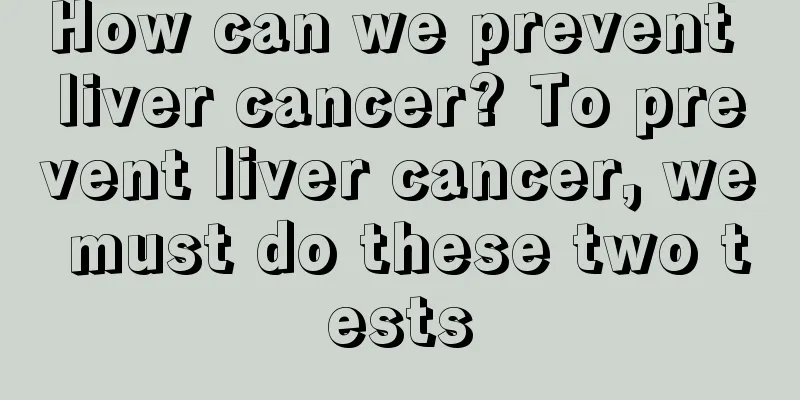How can we prevent liver cancer? To prevent liver cancer, we must do these two tests

|
Liver cancer usually refers to primary liver cancer. In my country, primary liver cancer is more common, with more than 400,000 new cases and more than 370,000 deaths each year. Primary liver cancer is so malignant, but most patients are already in the middle or late stages when they seek medical treatment, losing the best treatment opportunity. Therefore, early diagnosis and treatment of liver cancer are very important. March 18 is the 17th National Liver Care Day. This year's theme is "Early prevention and early treatment to prevent liver cancer." How can we prevent liver cancer? How can we find a liver protection method that suits us? Screening: Imaging examinations can improve the early diagnosis rate of liver cancer. Liver cancer has no symptoms in its early stages, and it is too late to seek medical treatment after symptoms appear. Therefore, early detection is the only way to achieve better treatment results. The development of modern medical diagnostic methods, especially imaging technology, has enabled more early liver cancers to be discovered, improving the overall cure rate of liver cancer patients. People at high risk of liver cancer include those infected with HBV or HCV, those with cirrhosis caused by various reasons, those who are long-term alcoholics and those with a family history of liver cancer. After the age of 35-40, these people should undergo serum alpha-fetoprotein (AFp) testing and liver ultrasound examination every 6 months. Once elevated AFp or "space-occupying lesions" in the liver area are found, more accurate CT and MRI examinations should be used. Of course, many people worry that it is liver cancer when they find liver nodules during physical examinations. In fact, in the absence of hepatitis virus infection, most liver nodules are benign lesions, such as hemangiomas, focal nodular hyperplasia, etc. These benign lesions will not become cancerous, but it is important to be careful not to misdiagnose liver cancer as other benign lesions, and benign liver nodules should also be checked regularly. Treatment: Radical treatment is chosen for early liver cancer, and resection is the first choice for those who can tolerate surgery. For early liver cancer, radical treatment methods should be chosen, including surgical resection, liver transplantation, ablation and other methods. Currently, the 5-year survival rate of early liver cancer after treatment is 50-70%. How to select the most suitable treatment method for early liver cancer patients through multidisciplinary comprehensive treatment methods, prolong survival time and improve quality of life is the most concerned issue for clinicians. In clinical practice, the appropriate initial treatment should be selected based on the patient's liver function, tumor size, number, location, technical strength of each medical unit, and patient willingness. Resection is the first choice for those who can tolerate surgery. For single liver cancer located deep in the liver with a diameter of less than 2 cm, local ablation therapy can achieve similar results to surgical resection. Liver transplantation is suitable for patients with poor liver function. |
<<: What tests should liver cancer patients take? 4 liver function tests for liver cancer
>>: What are the common symptoms of lung cancer? Common symptoms of lung cancer
Recommend
The echo of liver parenchyma is uneven
Ultrasound images show uneven echogenicity of the...
How to reduce internal heat after eating something that causes internal heat
If you have a poor diet and eat some high-calorie...
How to cure athlete's foot more thoroughly and effectively
Athlete's foot troubles many people, so in or...
Why does gas irritate my eyes?
Everyone knows how serious the harm that gas leak...
Which department should I go to for stuttering
Stuttering is what we often call stammering. Many...
Does foreign liquor need to be sobered up
Generally speaking, foreign liquor does not need ...
30 What to do if your facial skin is sagging
When people reach a certain age, the skin on thei...
Symptoms of secondary epilepsy
There are many epilepsy patients in our lives. We...
What should we do if teenagers are nearsighted? How to treat
Myopia in teenagers is usually caused by incorrec...
What to eat to treat gynecological problems
I believe everyone knows that food is the most im...
Are probiotics effective in regulating the intestines?
We all know that probiotics are bacteria that are...
How to treat premature heartbeat and slow heartbeat
The heart is the most critical organ in the human...
How to use a siphon coffee pot
The siphon coffee pot is a relatively common coff...
Is it good to drink Isatis root regularly
Isatis root has a certain effect in preventing co...
Prostate cancer radiotherapy pain, a few minutes each time
Prostate cancer radiotherapy pain, each time for ...









